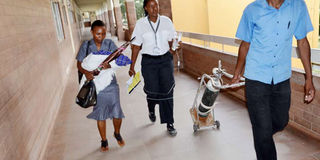Oxygen plants in counties breathe new life into patients

More and more county hospitals are investing in oxygen plants and saving lives and money in the process. PHOTO| KEVIN ODIT
The intricate process of breathing in and out comes easy for most of us. With each lungful of air, oxygen, a colourless gas that makes up 21 per cent of earth’s atmosphere, swooshes in to sustain life.
However, for patients like eight-month old Shamin, the process is not so easy, and access to the lifesaving gas is a matter of life and death. After suffering convulsions and fever, Shamin died in June this year after being rushed to hospitals in Kakamega, both private and public, which lacked lifesaving blood and oxygen.
So critical is oxygen in emergency care, that without it, pregnant women, newborns and children under the age of five, risk death if the gas is not available in hospitals. And lack is often the norm, rather than the exception, and where it is available, in short and irregular supply, it is often too expensive.
A spot-check by Healthy Nation showed that while in public hospitals children below five years are not charged for oxygen, in private hospitals they are charged about Sh300 per hour. In private hospitals, adults pay Sh2,000 per hour, which can run into millions of shillings if the patient is on oxygen continuously for a month.
LIFE-SAVING GAS
The body needs oxygen for the tissues, heart and other organs to function. When people breathe in oxygen, it burns sugar and fatty acids in the body to produce the energy the body runs on. When you breathe in, the oxygen goes to the lungs , then it is transported by red blood cells to the rest of the body.
Given its importance, oxygen was recently added, by the World Health Organisation, to the list of essential medicines that all hospitals must have. Hospitals in the counties have found a way to generate their own oxygen by installing gas plants.
Kisii Teaching and Referral Hospital; Busia, Siaya and Kakamega County Hospitals; Kitui General Hospital and Embu Level Five Hospital, have plants to produce their own oxygen.
Dr Enock Ondari, the CEO of the Kisii Teaching and Referral Hospital says that before installing an oxygen plant at the hospital, they would use Sh1.2 million a month to buy oxygen and rent cylinders from BOC Gases, but after investing Sh22 million in the plant, the hospital has enough oxygen for its needs and excess to sell to private hospitals to raise money to maintain the plant.
FILLS 10 CYLINDERS A DAY
The hospital fills 10 cylinders a day, and has contributed to a reduction of infant deaths from 46 to 40 per 1,000 births.
At Busia Referral Hospital, the functional oxygen plant installed in 2015 has averted many deaths and saved the hospital the money it was using to buy oxygen. Embu County Health
Executive Pauline Njagi, says that before installing the oxygen plant, the county level five hospital had to make difficult decisions on which of the emergency cases would get the little oxygen available. Now the hospital supplies level four hospitals in the county with oxygen.
Oxygen therapy is required for the management of many conditions in adults, women and children including pneumonia, acute respiratory illness and hypoxaemia. It is also essential for safe surgery, anaesthesia and obstetric care, as well as for ambulances and air rescue services.
Hypoxaemia, a lack of oxygen in the body, is usually caused by pneumonia and respiratory illnesses, and is a leading cause of death in children. According to Ministry of Health statistics, pneumonia killed 22,473 Kenyans in 2015, up from 21,640 the previous year. The World Health Organisation estimates that oxygen therapy could reduce child deaths from pneumonia by 35 per cent annually, if the therapy was available in all hospitals.
“We have lost so many children with pneumonia because they have to be transported from a health centre to a facility which is far away on unpassable roads. They often succumb on the way. Oxygen should not be a matter of location or luck, it should be widely available,” Dr Walter Otieno, a paediatrician in Kisumu told Healthy Nation.
Children also require oxygen if they are hyperventilating. If a child’s oxygen saturation is below 95 per cent, he is placed on oxygen to ease breathing. Kidney and heart failure also lead to low oxygen levels that need medical intervention.


